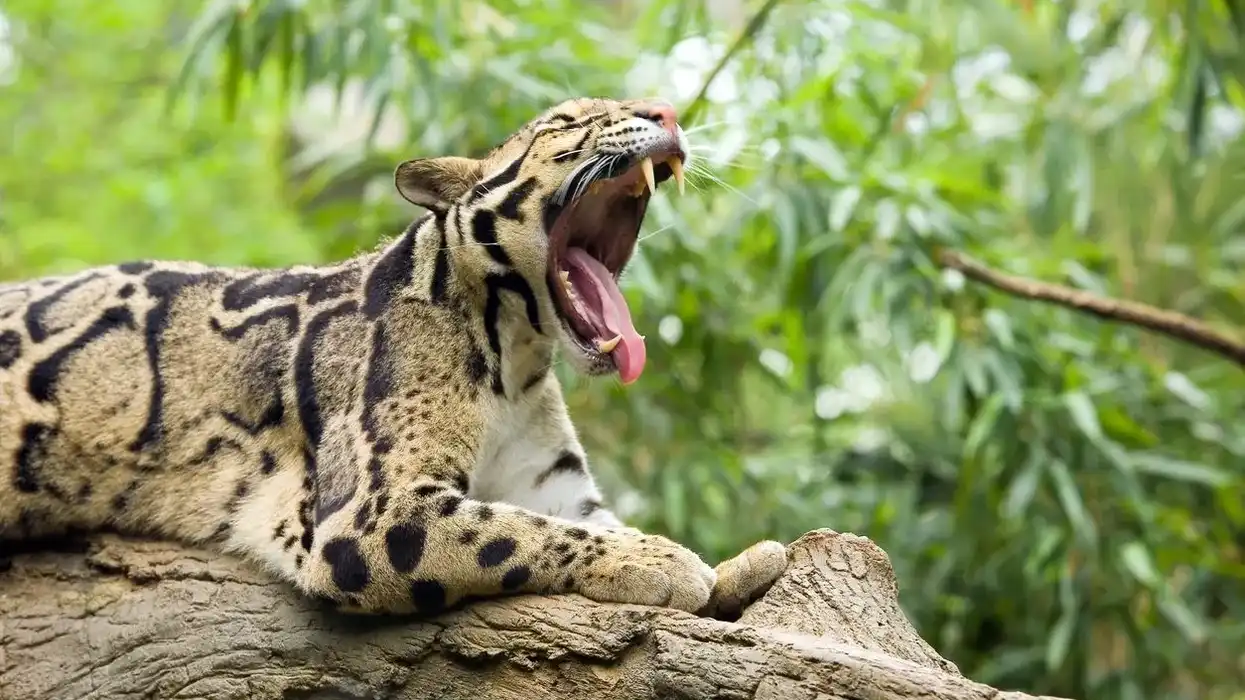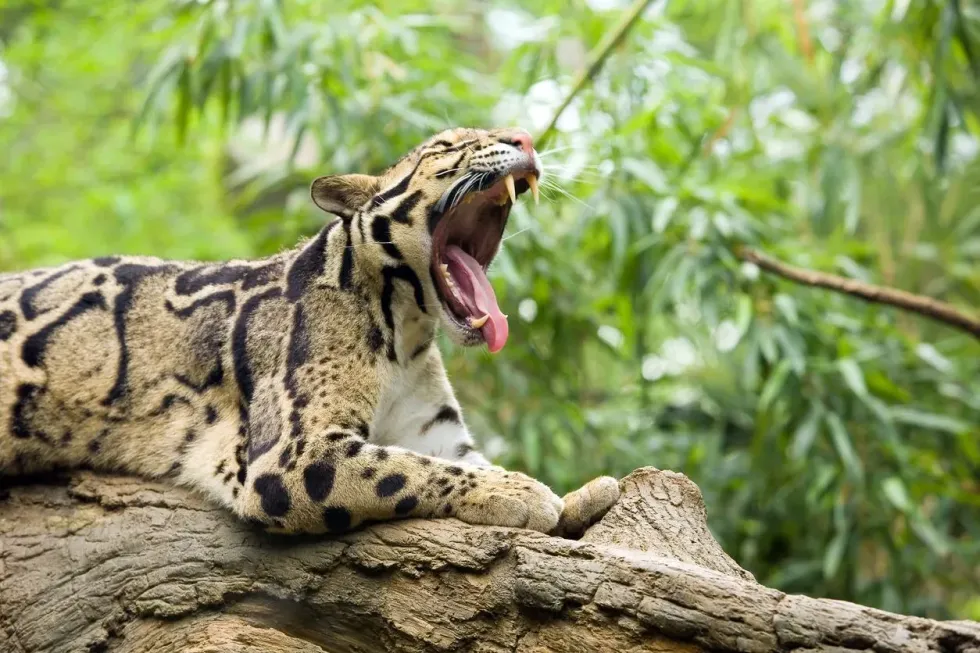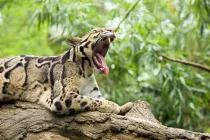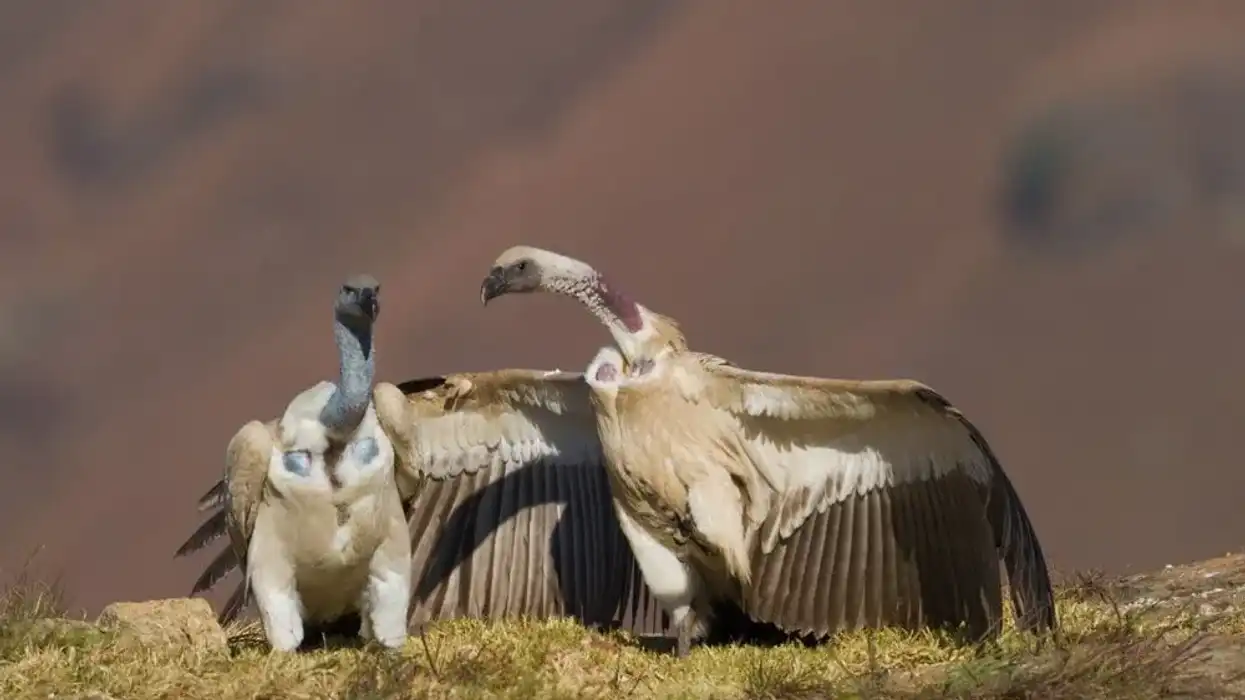Fun Clouded Leopard Facts For Kids

If you want to read about rare animals, the rare cat also known as the clouded leopard should be top of your list. The clouded leopard (Neofelis nebulosa) is a feline cat that lives in Asia.
They are shy and secretive animals that can be hard to spot. Amongst this cat species, three subspecies are known.
They are the Neofelis nebulosa that occupy areas covering the southern parts of China to the Malaysian mainland.
The second subspecies is known as the Neofelis nebulosa macrosceloides that reside in the Himalayas in Nepal and India to areas in Myanmar and Bangladesh. The third species was called the Formosan Clouded Leopard or the Neofelis nebulosa brachyura but they have been declared extinct these days.
Until 2007, the fourth subspecies of the Sunda clouded leopard (Neofelis diardi) was considered part of the Neofelis nebulosa. However, further studies showed that Sunda clouded leopard (Neofelis diardi) that lived in Borneo and Sumatra were different species altogether.
So, read on for more information about the clouded leopard. For facts on other animals, take a look at the striped polecat and the ocelot.
Clouded Leopard Interesting Facts
What type of animal is a clouded leopard?
Clouded leopards (Neofelis nebulosa) are wild cats that live in the tropical forest areas of Southeast Asia, Southern China, and in the foothills of the Himalayas. The clouded leopard's scientific name is Neofelis nebulosa.
What class of animal does a clouded leopard belong to?
The clouded leopard (Neofelis nebulosa) belongs to the class Mammalia and the order Carnivora, family Felidae.
How many clouded leopards are there in the world?
Due to the shy and deceptive nature of the wild clouded leopard, no concrete data is present for clouded leopard populations in the wild. However, it is estimated that there are around 10,000 clouded leopards and no single group of the population has more than 1000 individuals in it.
Where does a clouded leopard live?
Clouded leopards are spread throughout southern and southeastern Asia. These wild cat species are mainly found in the foothills of the Himalayas, especially in the mountainous forest areas of Bhutan, Nepal, and some parts of India.
Southern China, Myanmar, Thailand, Cambodia, Laos, and Malaysia are some of the other countries where we see the clouded leopards. They are mainly known to occupy tropical rainforests, shrublands, mangrove swamps and have been observed to be present as high as 12,000 ft above sea level.
What is a clouded leopard's habitat?
The clouded leopard was once thought to be a very secretive cat species. They are mainly found in the tropical forest habitat.
Apart from their primary tropical forest habitat, the clouded leopard habitats also include shrublands and wet swamps. This wild cat with cloud-like patterns on them is thought to be nocturnal and arboreal.
This means that they are usually active during the night and that they spend most of their time on tree trunks. Their arboreal abilities make them one of the best climbers in either small cats or big cats.
The Neofelis nebulosa (clouded leopard) has characteristics that help it descend down trees like squirrels.
They can even hang upside down from the trees and their branches while climbing those trees by just using their hind feet. Interestingly, the clouded leopard has also been observed to be crepuscular which means that they are active during the twilight period of the day!
However, recent research has suggested that despite spending the day resting on trees, clouded leopards spent a lot more time on the ground than previously thought. Captive clouded leopards are known to mark their territories by spraying urine on spots like trees and rocks and also by rubbing their heads against significant objects.
Who do clouded leopards live with?
Due to their shy nature, very little is known about the mentality of the clouded leopard in the wild. It is assumed like all the small cats and the big cats in their habitat, Clouded Leopard is also solitary in nature.
This wild cat hasn't been seen traveling in groups unless females have clouded leopard clubs with them. Male clouded leopards have always been seen to very solitary in nature.
How long does a clouded leopard live?
The average age for the clouded leopard in the wild is thought to be around 11 years, however individual cats who have been captive are known to live between 12 and 15 years of age. Also, there has been the observed case of one clouded leopard who lived almost till the age of 17.
How do they reproduce?
The process of reproduction between male and female clouded leopards can be violent. Due to their secrecy and decreasing numbers, mating habits in the wild have not been observed properly.
However, these species of cats have bred in captivity. But, that process can often lead to a lot of aggression and violence between males and females. Males often bite the females on their neck during mating and this can lead to the death of the female.
It has been seen that males who have grown up with females cause no such problems during mating. However, adult males are introduced to adult females, the death of the female during breeding is very common.
Once the mating process is over, female clouded leopards have a gestation period of around 87 to 99 days, with the common average being 93 days. The clouded leopard cubs are usually born in a litter containing one to four clubs.
Each clouded leopard cub is born blind and most of them are known to open their eyes about ten days after their birth. For the cubs, the distinct cloud-like patterns develop when they reach six months of age.
What is their conservation status?
Due to its uniqueness and general secretive nature along with the effects of habitat loss, the clouded leopard's conservation status as listed by the International Union For Conservation Of Nature is Vulnerable. This endangered species status is also because clouded leopard species are hunted for their beautiful fur.
One subspecies of these cats that lived in Taiwan is listed as extinct.
Clouded Leopard Fun Facts
What do clouded leopards look like?
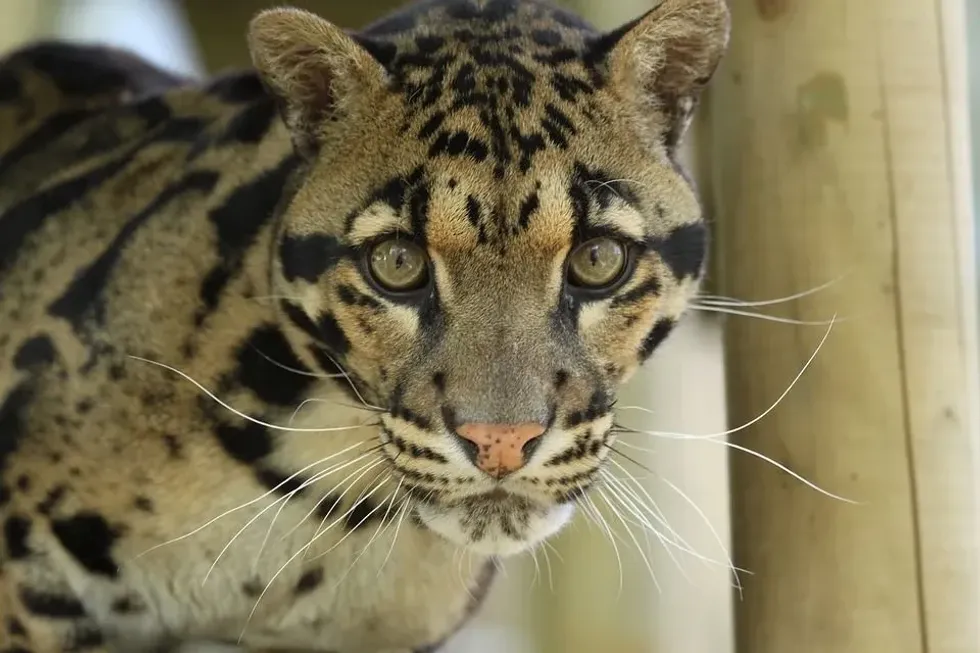
Although not a leopard, clouded leopards still belong to the family of cats. The clouded leopard skull is narrow, low, and long while they have the biggest canine teeth amongst cats when considered as a proportion to their bodies.
These canines often help them catch prey and can open up at an angle of 100 degrees. The clouded leopard eyes have pupils that can contract into vertical slits. Their irises are generally grayish-green to yellow.
The legs of this species are small and stout but its hind feet are bigger in comparison to the forefeet as this helps them in climbing trees and other actions. They also have a pale pink or whitish muzzle.
Coming to the fur, the clouded leopard species gets its name from the cloud-like blotches on its fur. These cats have fur that is of the color ochre yellow or dark grey, along with black and dark grey blotches.
The ears of these cats are blacks and the head is spotted with black marks. The tails of the clouded leopards are also spotted in appearance. They have these blotches and stripes running all through their body.
How cute are they?
Like most cats, clouded leopards have qualities and physical characteristics that can indeed come across as cute. But, don't be fooled by their appearance.
This cat is a very aggressive animal that can attack quite ferociously with its long canine teeth, whenever it feels threatened. The males are even known to commonly kill their females during mating with violent behavior.
How do they communicate?
The communication of the clouded leopards occurs through different vocalizations. They have a different bone structure than the other cats that restricts them to roar like any other big cat while also preventing them from purring like any small cat.
The way these clouded leopards express themselves is through hissing, growling. When threatened, they expose their canines and give off a low-pitched growl.
They are also known to have a loud meow sound which helps them locate one another. Others ways of communication include chuffing and raising their muzzles in a friendly manner when they meet another cat from their species.
How big is a clouded leopard?
The clouded leopard size compared to human beings is about one-third of an average human being. These clouded leopards stand at around 20 in - 22 in at their shoulders and have a length of 27 in - 43 in, accompanied by a tail that ranges from 24 in - 36 in.
How fast can a clouded leopard run?
Due to the low availability of data and research on the clouded leopards, the exact running speed is not known. What is known is that these cats are fast runners whose balance while running is helped by their tails.
However, there are some sources that say that clouded leopards can run up to speeds of 40 miles per hour in the wild.
How much does a clouded leopard weigh?
Clouded leopards are interesting in the sense that they are not as big as some of the big felines while not being as small as the smaller felines. Their size kind of acts like a bridge between the bigger and smaller cats.
Clouded leopards usually weigh between 25 lb and 51 lb. Sexual dimorphism is seen in clouded leopards with males being slightly bigger than females.
What are their male and female names of the species?
Unfortunately, the clouded leopard species do not have any distinct names for the females and males of the species.
What would you call a baby clouded leopard?
Clouded leopard cubs are usually called kittens, which is in tandem with the name of the cubs of all the feline species.
What do they eat?
Clouded leopards are carnivores in nature. They are known to hunt for their prey and eat them.
After eating their prey, they are known to retreat to trees in order to digest the food. Their prey includes deer, pigs, monkeys, squirrels, birds, and other animals found in the tropical forests and wetlands. Clouded leopards are also known to eat pangolins, porcupines, and binturongs.
Are they dangerous?
As these animals are carnivorous and aggressive in nature, they can be quite dangerous when they feel irritated or threatened.
Would they make a good pet?
Of course not. Despite belonging to the feline family, these wild cats that are also endangered can never be a good choice for a pet.
They are dangerous and suited to the wild and can easily attack the inhabitants in any human home. We can presume that they might also make prey out of the other pets in the house.
Clouded leopards are only either found in the wild or in zoos and are never kept as pets.
Did you know...
Clouded leopards, due to their superior jumping skills, are known to easily jump up to a height of around four feet.
The territorial home range of the clouded leopards, including males and females, is thought to be between the range of eight square miles and 20 square miles.
The upper pair of the clouded leopard's canines usually measure around 1.6 inches. In some cases, they are even longer. However, the most astonishing fact is that these rare cats have a bite force that has been measured to be around 545 Newtons.
What eats clouded leopards?
Owing to their secretive nature, the clouded leopards have no real natural predators in the jungle. However, clouded leopards may come to blows with tigers and leopards with whom they compete for food on occasions. However, humans have been known to hunt and eat these rare cats.
Why is the clouded leopard endangered?
The clouded leopard is endangered in the wild now due to the main reason being habitat loss across their territories due to deforestation, either for commercial purposes or for agriculture.
Other than the threat to their habitat, this species also face grave danger in the form of poaching from humans who hunt them in great numbers due to their unique fur coat and canine teeth.
Here at Kidadl, we have carefully created lots of interesting family-friendly animal facts for everyone to discover! Learn more about some other mammals including the Tasmanian tiger and the Sumatran tiger.
You can even occupy yourself at home by drawing one of our Clouded leopard coloring pages.
We Want Your Photos!
More for You
See All
Bachelor of Arts specializing in Journalism and Mass Communication, Postgraduate Diploma in Sports Management

Moumita DuttaBachelor of Arts specializing in Journalism and Mass Communication, Postgraduate Diploma in Sports Management
A content writer and editor with a passion for sports, Moumita has honed her skills in producing compelling match reports and stories about sporting heroes. She holds a degree in Journalism and Mass Communication from the Indian Institute of Social Welfare and Business Management, Calcutta University, alongside a postgraduate diploma in Sports Management.
Bachelor of Law

Abdulqudus MojeedBachelor of Law
A versatile professional with a passion for creative writing and technology. Abdulqudus is currently pursuing his Bachelor of Law from the University of Lagos and has experience as a tutor, intern assistant, and volunteer. He possesses strong organizational skills and is a detail-oriented person.
Disclaimer
1) Kidadl is independent and to make our service free to you the reader we are supported by advertising. We hope you love our recommendations for products and services! What we suggest is selected independently by the Kidadl team. If you purchase using the Buy Now button we may earn a small commission. This does not influence our choices. Prices are correct and items are available at the time the article was published but we cannot guarantee that on the time of reading. Please note that Kidadl is a participant in the Amazon Services LLC Associates Program, an affiliate advertising program designed to provide a means for sites to earn advertising fees by advertising and linking to Amazon. We also link to other websites, but are not responsible for their content.
2) At Kidadl, we strive to recommend the very best activities and events. We will always aim to give you accurate information at the date of publication - however, information does change, so it’s important you do your own research, double-check and make the decision that is right for your family. We recognise that not all activities and ideas are appropriate for all children and families or in all circumstances. Our recommended activities are based on age but these are a guide. We recommend that these ideas are used as inspiration, that ideas are undertaken with appropriate adult supervision, and that each adult uses their own discretion and knowledge of their children to consider the safety and suitability. Kidadl cannot accept liability for the execution of these ideas, and parental supervision is advised at all times, as safety is paramount. Anyone using the information provided by Kidadl does so at their own risk and we can not accept liability if things go wrong.
3) Because we are an educational resource, we have quotes and facts about a range of historical and modern figures. We do not endorse the actions of or rhetoric of all the people included in these collections, but we think they are important for growing minds to learn about under the guidance of parents or guardians.
